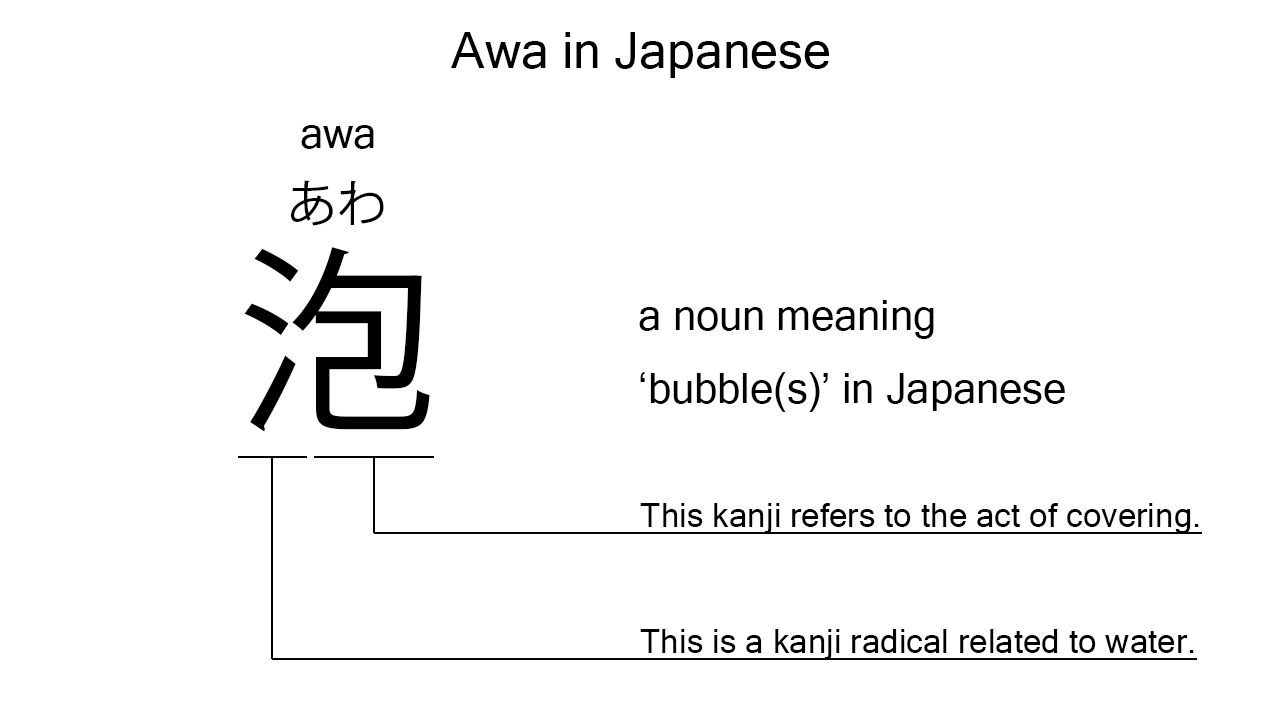What does “awa” mean in Japanese?
Native speakers say “awa” often to mean ‘bubble’ in Japanese. Perhaps, some Japanese learners know this word as it is sometimes used in Japanese movies, songs, novels, manga, anime, and the like. In this blog post, however, I will explain this word in detail based on its kanji character. And also, I will explain how to use it through example sentences. My explanations would help Japanese learners understand “awa” more clearly. Then, let’s get started!
Contents
Definition and meanings of “awa”
Let me start with the definition and meanings of “awa”.
- awa – 泡 (あわ) : a noun meaning ‘bubble’ or ‘foam’ in Japanese. This can also work as plural. Learn more about Japanese plural.
Native speakers use this noun to refer to air surrounded by a ball-shaped thin layer or the layer itself. So, the usage is similar to those of the English nouns written above.
The definition and meanings are simple and clear. To understand this noun more clearly, however, let me explain its kanji character in detail.
What does “awa” literally mean in Japanese?
The kanji character of “awa” consists of the following two parts:
- 氵 : a kanji radical related to water.
- 包 : a kanji character used to refer to the act of wrapping or covering.
From these two parts, we can understand that “awa” literally means ‘water covering’ in Japanese. This literal interpretation is not completely in line with the actual meanings, but still understandable, I think. Bubbles and foam are often observed as something covering the surface of water.

When we meet new kanji characters, we should check their parts in detail to understand their meanings clearly and deeply. In many cases, kanji parts tell us a lot about the meanings of the characters they form. Actually, here, we could get the better understanding of “awa” through the detailed check above.
So far, I’ve explained the definition and meanings of “awa” together with its kanji parts. Then, let me explain how to use it through the example sentences below.
Example #1: how to say “bubbles” in Japanese
suimen de awa ga dekiru – 水面で泡ができる (すいめんであわができる)
Bubbles form on the surface of water.
Below are the new words used in the example sentence.
- suimen – 水面 (すいめん) : a noun meaning ‘surface of water’ in Japanese. The first kanji means ‘water’; the second means ‘surface’.
- de – で : a case particle used to say where something happens. In the example, this is used after “suimen” to say where the bubbles form.
- ga – が : a case particle used to make the subject word or the object word in a sentence. In the example, this is used after “awa” to make the subject in the sentence.
- dekiru – できる : a verb meaning ‘to form’ or such in Japanese.
This is a typical usage of “awa”. In this example, it works as plural and means ‘bubbles’ in Japanese. When we want to mean a ‘bubble’ or ‘bubbles’ in Japanese, this noun is a very good option.
Example #2: another usage of “awa”
zenbu mizu no awa ni nat ta – 全部水の泡になった (ぜんぶみずのあわになった)
Everything ended up being wasted.
Below are the new words used in the example sentence.
- zenbu – 全部 (ぜんぶ) : a noun meaning ‘all’, ‘everything’, or such in Japanese.
- mizu – 水 (みず) : a noun meaning ‘water’ in Japanese.
- no – の : a case particle joining two nouns. Normally, the first one can work as a modifier to describe the second. In the example, this works to join “mizu” and “awa”. The formed phrase literally means ‘bubbles of water’ in Japanese. Word orders in Japanese and English are different, but the role of this case particle is similar to that of the English preposition, “of”.
- ni – に : a case particle used to say what someone or something becomes after a change or action. In the example, this is used after “mizu no awa” to say what everything has become.
- nat – なっ : one conjugation of the verb, “naru”, which means ‘to become’, ‘to get’, ‘to turn’, or such in Japanese. In the example, it has been conjugated for the better connection with its following word.
- ta – た : an auxiliary verb used after a verb, adjective, or auxiliary verb to make its past tense form. Probably, this is well known as a part of Japanese ta form. In the example, this is used after “nat” to make its past tense form, “nat ta”.
This is another typical usage of “awa”. In this example, it works as a part of the commonly-used phrase, “mizu no awa ni nat ta”, which means ‘to have ended up being wasted’ in Japanese. Native speakers sometimes say “mizu no awa” to refer to waste or meaningless results in Japanese. It’s worth knowing.
Summary
In this blog post, I’ve explained the definition and meanings of “awa” in detail based on its kanji character. And also, I’ve explained how to use it through the example sentences. Let me summarize them as follows.
- awa – 泡 (あわ) : a noun meaning ‘bubble’ or ‘foam’ in Japanese. This can also work as plural. Native speakers use this noun to refer to air surrounded by a ball-shaped thin layer or the layer itself. The left part of this kanji is related to water; the right part refers to the act of covering. So, this kanji character literally means ‘water covering’ in Japanese. This literal interpretation is not completely in line with the actual meanings, but still understandable, I think. Bubbles and foam are often observed as something covering the surface of water.
Hope my explanations are understandable and helpful for Japanese learners.